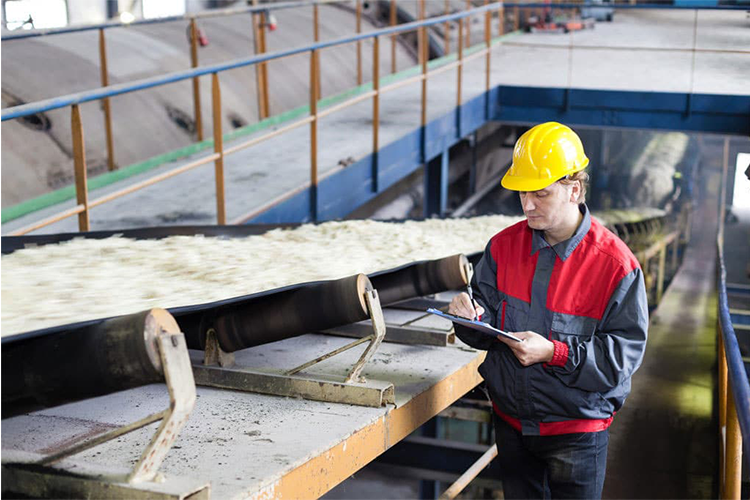Conveyor systems are critical components in many industrial operations, and their failure can lead to costly downtime and safety hazards. So, it’s essential to know how to inspect a conveyor to ensure it continues running safely and efficiently.
A thorough conveyor inspection involves checking the belt condition, tracking alignment, roller function, motor performance, and safety devices while following a systematic checklist, typically performed daily or weekly depending on usage.
While this basic inspection process sounds straightforward, several different types of inspections must be performed at various intervals, and missing any of these could lead to serious problems. The rest of this article will explain what to check during daily, weekly, monthly, and annual inspections to ensure you’re not overlooking any critical components.
What Are The Different Types Of Conveyor Inspections?
Daily inspections focus on immediate safety and operational concerns. These quick visual checks include looking for apparent belt damage, listening for unusual noises, ensuring emergency stops are functional, and ensuring safety guards are in place. This usually takes about 15 minutes and should be done at the start of each shift.
Weekly inspections are more detailed, including checking belt tracking, roller condition, drive chain tension, and material buildup around pulleys and rollers. These typically take 30-60 minutes and should be performed by maintenance personnel familiar with the equipment.
Monthly inspections concentrate on mechanical components and electrical systems. This includes checking motor amperage, belt tension, bearing temperature, and gearbox oil levels. These inspections usually require 2-3 hours and may need specialized tools or testing equipment.
What Are The Most Common Signs Of Conveyor Problems?
Early detection of conveyor issues can prevent major breakdowns. One of the most obvious signs is unusual noise, such as squealing, grinding, or thumping sounds, which often indicate bearing problems or misalignment. Visual indicators include frayed belt edges, material spillage, or uneven wear patterns on the belt surface.
Another red flag is when the belt starts tracking poorly or wandering from side to side. This usually means there’s an alignment issue with the rollers or pulleys. If left unchecked, this can lead to severe belt damage and potential system failure.
Excessive dust accumulation, belt slippage, or irregular stop/start operations are also warning signs that shouldn’t be ignored. These issues often indicate that the system needs immediate attention to prevent more serious problems.
What Safety Precautions Should Be Taken During Conveyor Inspection?
Before beginning any inspection, the conveyor must be properly locked out and tagged out according to OSHA regulations. This includes disconnecting and securing all power sources and waiting for all moving parts to come to a complete stop.
Inspectors should wear appropriate personal protective equipment (PPE), including safety glasses, steel-toed boots, and hard hats. Loose clothing, jewelry, or long hair must be secured to prevent entanglement in machinery.
Access to the inspection area should be restricted to authorized personnel only, especially when inspecting a rotating conveyor, and proper lighting must be available to ensure all components can be thoroughly examined. Fall protection equipment must be used according to safety regulations when working at heights.
How Often Should Conveyor Belts Be Replaced?
The typical lifespan of a conveyor belt ranges from 2 to 5 years, though this varies significantly based on usage, maintenance, and operating conditions. Heavy-duty applications in harsh environments may require replacement every 18 months, while well-maintained systems in clean environments can last up to 8 years.
Several factors indicate when replacement is necessary. If the belt shows signs of severe wear, such as exposed cording, significant cracking, or missing chunks of material, immediate replacement is required. Additionally, if repairs become frequent or belt tension can no longer be adequately maintained, replacing the belt’s usually more cost-effective.
Preventive replacement should be scheduled before complete failure occurs. This allows for planned downtime rather than emergency repairs, which can be much more costly and disruptive to operations.
What Are The Costs Of Neglecting Conveyor Maintenance?
The financial impact of poor conveyor maintenance can be substantial. Emergency repairs typically cost 3-5 times more than planned maintenance, and unexpected downtime can cost thousands of dollars per hour in lost production.
Beyond direct repair costs, neglected maintenance can lead to increased energy consumption due to inefficient operation. A poorly maintained conveyor system can use up to 40% more power than one that receives regular maintenance. This extra energy usage adds up significantly over time.
Safety incidents resulting from maintenance neglect can be even more costly. According to industry statistics, conveyor-related accidents can result in fines, legal expenses, and workers’ compensation claims exceeding $100,000 per incident. Additionally, such incidents can damage company reputation and employee morale, leading to long-term negative impacts on the business.
Taking Action On Your Conveyor Inspection Program
The most important step now is to create a detailed inspection checklist that includes daily, weekly, monthly, and annual tasks based on your specific conveyor system and operating conditions. Take this checklist to your maintenance team and work together to establish a regular inspection schedule that everyone can follow consistently. This simple action will help prevent costly breakdowns and ensure your conveyor system operates safely and efficiently for years.
